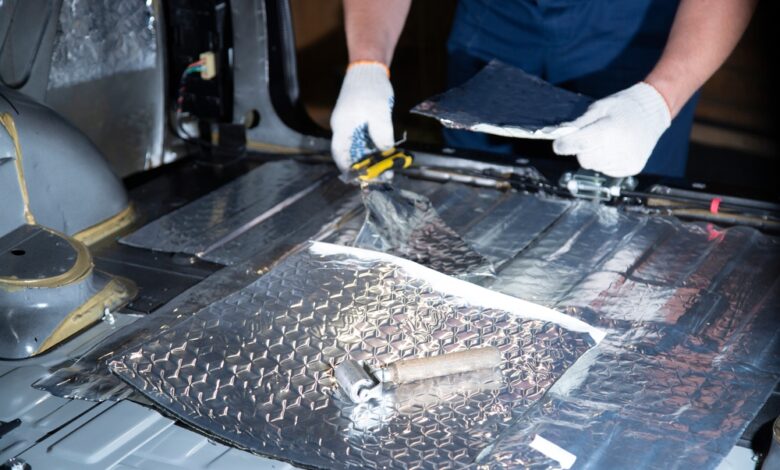
Imagine you’re on a road trip with your friends, excited to enjoy the drive with your favorite songs. But as you reached the highway, the loud noise from other cars and the wind makes it hard to hear anything clearly. Conversations are tough, and and the music doesn’t sound as good. This is where sound insulation can help. Using sound damping sheets, you can block out a lot of the noise that comes into your car. These sheets make your car quieter, so you can enjoy your music and talk with friends without shouting. In this blog, we will discuss why sound insulation is so important for your car and how it helps your driving experience..
What is Sound Insulation in Vehicles and Why is it Necessary?
Sound insulation in vehicles is the use of materials and procedures that reduce or prevent unwanted noise from entering the cabin. This noise can come from multiple sources, including the engine, road, and wind. Sound insulation is necessary because it provides a quieter and more comfortable environment for the users. It helps drivers to enjoy music, conversations, and a more comfortable driving experience without being interrupted by extraneous noise.
How Does Sound Insulation Enhance the Driving Experience in Vehicles?
Sound insulation improves driving experience for reducing unwanted sounds within the car. It helps to a quiet and peaceful environment, which allows you to focus better and have a more enjoyable ride. With effective sound insulation:
- Reduces Road Noise: It blocks the sound from tires and the road surface, making the cabin quieter.
- Improves Audio Quality: It enhances the quality of music and conversations by reducing background noise.
- Decreases Driver Fatigue: A quieter environment helps reduce stress and tiredness on long drives.
- Increases Comfort: It creates a more pleasant atmosphere, making every trip more enjoyable.
- Blocks Engine Noise: It minimizes the sound from the engine, allowing for smoother communication inside the vehicle.
What Are the Common Sources of Noise in a Vehicle?
- Engine Noise: The engine produces vibrations and sounds, especially at high speeds or during acceleration.
- Road Noise: Tires make noise as they roll over different road surfaces, including bumps and potholes.
- Wind Noise: Wind creates noise as it moves around the vehicle, particularly at higher speeds or through gaps in doors and windows.
- Brake and Suspension Noise: Brakes and suspension components can squeak or clunk during braking or when driving over uneven surfaces.
- Interior Rattles: Loose parts inside the car, such as dashboard components or door panels, can rattle and create distracting sounds.
How Do Sound Damping Sheets Work in Vehicle Sound Insulation?
The sound damping sheets absorb and block sound waves, which reduces noise in cars. When you placed these sheets to the interior surfaces of your car, such as the doors, floor, and trunk, they prevent vibrations and rattles that create noise. The sheets are made of materials that convert sound energy to heat, which is then dissipated. This procedure quiets the vehicle’s cabin for reduce road noise, engine sounds, and other exterior disturbances, which leads in a more comfortable and quiet driving experience.
What Materials are Used in Sound Damping Sheets?
Sound damping sheets are made from various materials designed to absorb and reduce noise effectively. These materials include:
- Butyl Rubber: Butyl rubber is a common material in sound damping sheets. It absorbs vibrations effectively and is flexible, making it easy to apply to various surfaces in a vehicle.
- Aluminum Foil: Aluminum foil layers are often added to sound damping sheets. They help in reflecting heat and providing additional sound insulation by blocking noise.
- Foam: Foam layers, often made from polyurethane or melamine, help to absorb sound waves and reduce vibrations. They are lightweight and can be easily cut to fit various shapes.
- Asphalt-Based Materials: Asphalt-based sheets are heavy and dense, making them effective at reducing noise. They are particularly good at dampening low-frequency sounds.
- Polyurethane: Polyurethane is sometimes used for its sound-absorbing properties. It helps in reducing both airborne and structure-borne noise, making the vehicle’s cabin quieter.
Why Are Sound Damping Sheets Necessary for Reducing Noise Levels Inside a Vehicle?
Sound damping sheets are necessary for reducing noise levels inside a vehicle for several reasons:
- Effective Noise Reduction: They are designed to specifically target and reduce a wide range of noise frequencies.
- Enhanced Comfort: They make the cabin quieter, contributing to a more comfortable ride.
- Improved Audio Experience: By reducing background noise, they enhance the clarity and quality of the car’s audio system.
- Vibration Control: They minimize vibrations that can cause noise and discomfort.
- Durability: These sheets are durable and long-lasting, providing ongoing noise reduction benefits.
Where Are Sound Damping Sheets Typically Installed in a Vehicle?
- Doors: Sound damping sheets are commonly installed on the inner panels of doors to reduce noise from outside the vehicle.
- Floor: They are applied to the floor pan to minimize road noise and vibrations that enter the cabin from underneath.
- Trunk: Sheets are often used in the trunk area to dampen noise and vibrations caused by road conditions.
- Roof: They may be installed on the roof to further reduce airborne noise and echoes within the vehicle.
- Firewall: Sheets are placed on the firewall to block engine noise and heat from entering the cabin.
How to Apply Sound Damping Sheets in a Vehicle?
- Prepare Surfaces: Clean and dry the areas where you will apply the sheets, such as doors, floor, and trunk.
- Cut Sheets to Fit: Measure and cut the damping sheets to match the size and shape of the surfaces you’re treating.
- Peel and Stick: Remove the backing from the sheets and firmly press them onto the prepared surfaces.
- Apply Pressure: Use a roller or apply pressure with your hands to ensure the sheets adhere well and eliminate air bubbles.
- Cover Entire Area: Cover all desired areas comprehensively to maximize sound insulation effectiveness throughout the vehicle.
What Are the Signs that my Vehicle Needs Better Sound Insulation?
- Loud Road Noise: You constantly hear loud noises from the road while driving, which can make conversations and listening to music difficult.
- Engine and Exhaust Sounds: You can easily hear the engine and exhaust sounds inside the cabin, especially at high speeds or when accelerating.
- Vibrations and Rattles: You notice vibrations and rattling noises from different parts of the vehicle, indicating poor sound dampening.
- Tire Noise: The noise from the tires rolling on the pavement is very noticeable, creating an unpleasant driving experience.
- Difficulty Hearing Passengers: You struggle to hear passengers clearly, even when they’re speaking at a normal volume.
Reduce Your Vehicle Interior’s Noise With Polycrafts Sound Damping Sheets
Polycrafts is a leading automotive parts manufacturer in Pakistan, which is recognized for its products which encourage vehicle comfort and safety. Polycrafts provides sound insulation solutions like sound damping sheets as well as durable automotive parts to make every journey quieter and more enjoyable. Their expertise in sound insulation technology helps to reducing noise levels inside cars, which leads to a more comfortable driving experience. Polycrafts stays the industry leader in producing necessary automotive parts that improve road safety and passenger comfort, due to its commitment to quality and innovation.
Final Thoughts on Why Sound Insulation Important for Vehicles
Sound insulation is an important component of vehicle comfort and functionality. Vehicle owners can greatly enhance their driving experience by understanding the significance and benefits of sound damping sheets. Sound insulation makes a significant effect in reducing engine, road, and wind noise. Making choices in high-quality sound damping sheets and properly placing them can change your vehicle into a quieter, more pleasant area.
Make sure to explore the rest of the site for more Fascinating Blogs!



